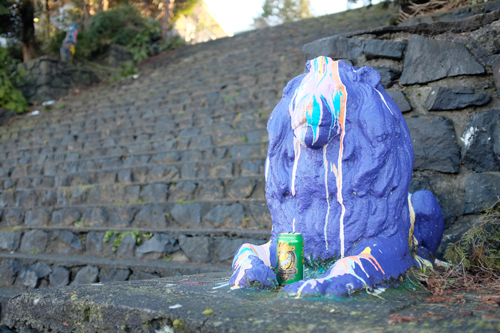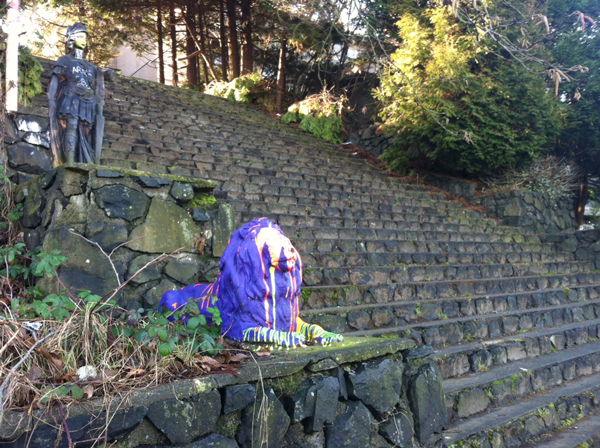Ashley McLellan
The staircase at the end of the alleyway next to my old apartment building looked as though it was a forgotten ruin from the distant past. Built to reflect classical aesthetics, the stairs were not long but wide and steep, constructed from what appeared to be paving stones of various sizes on the front, and concrete on top. On the east side, three small statues flanked them—a lion, the bust of a woman and a warrior-like figure; on the west side there was only one statue, a lion. Given the relatively short history of the city, the stairs were not a ruin or the remaining part of some larger structure, but were most likely constructed in the late 1960s. They were built to appear like a ruin, an idea reinforced by their incongruous position in the surrounding landscape. Bordered at the base by a busy street, at the top by a long steep alleyway and on either side by overgrown bushes or lopsided trees.

Image courtesy Megan McLellan.
I moved into the one-bedroom apartment in the building at the top of the long, steep alleyway in mid-August after spending most of my summer searching for a place. It was late one night near the end of that first month that my ex discovered the stairs. Friends dropped him off at the foot of the stairs, after a long summer night of drinking. From the bottom, it was difficult to decipher where the stairs might emerge, and at night they were poorly lit making them somewhat unappealing. The only thing that propelled him forward was the vague notion that they might somehow lead to our building. While his discovery piqued my own interest, I didn’t seek this path out for a few more weeks. On my way to class, instead of walking through the open park, I decided to turn down the alley. From the top, I made my way down to a gravel landing, which seemed to double as a terrace for an apartment in the rundown building next to ours. The alley was eerie and unsettling. However, reaching the top of the staircase momentarily suspended this feeling. The stairs were a peculiar element that intervened in the overgrown, rundown surroundings. Although they seemed out of place they also managed to blend in, and were therefore an ideal place for drinking and taking drugs, evidenced by the broken bottles and discarded drug baggies.
Over the next couple of months the stairs became more familiar as I passed through them on what was almost a daily basis. At a certain point in the winter, they became difficult to navigate due to wet and icy conditions and I was forced to walk the long way around. This period didn’t last long, and in spring after my ex moved out and my sister moved in, we once again cut down the alley dashing off to work and school. Despite my interest in thinking of the stairs as a mystical reprieve from my daily routine, I never sought to discover more about them. However, by not digging up the past of this architectural enigma, the stairs became a part of my present and not the past. They were not a reminder of what was, but existed and changed in the present moment. When someone dumped paint over the statues, I did not mourn the defacing of the ruin, because the paint too became incorporated into how I experienced the space.
Ruins are often thought of as a testament to what was, they are remains of something that is no longer whole but serves as a reminder of what was once wholly there. They are often popular destinations that foster an affective environment of quiet contemplation. Yet ruins also provide an opportunity to rethink our relationship to the past and present and our physical relationship to space. For a time, I allowed my initial experience of the stairs to be clouded by an idea of some connection to the past. Later, the stairs came to be symbolic of my failed relationship, or my relationship in ruins. However, the staircase was always part of my present. I passed through the space regularly; it was a shortcut that was both visually pleasing and physically demanding. The original intention for the design and construction of the space never mattered, they were intended to be passed through from the top to the bottom (and vice versa) and were therefore not defined by how they no longer functioned but by how they continued to function, and might continue to function, as part of the urban environment.

Image courtesy Kendra McLellan.
Ashley McLellan is an emerging writer and editor originally from Vancouver, BC. Currently based in Toronto, Ontario, she will begin her MA in art history this fall at York University. Her writing has previously appeared online for Canadian Art and Artinfo Canada.